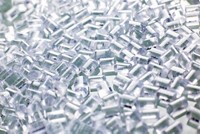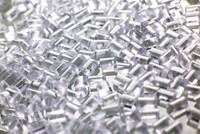Advertisement
Grab your lab coat. Let's get started
Welcome!
Welcome!
Create an account below to get 6 C&EN articles per month, receive newsletters and more - all free.
It seems this is your first time logging in online. Please enter the following information to continue.
As an ACS member you automatically get access to this site. All we need is few more details to create your reading experience.
Not you? Sign in with a different account.
Not you? Sign in with a different account.
ERROR 1
ERROR 1
ERROR 2
ERROR 2
ERROR 2
ERROR 2
ERROR 2
Password and Confirm password must match.
If you have an ACS member number, please enter it here so we can link this account to your membership. (optional)
ERROR 2
ACS values your privacy. By submitting your information, you are gaining access to C&EN and subscribing to our weekly newsletter. We use the information you provide to make your reading experience better, and we will never sell your data to third party members.
Business
GE Exits Plastics With Sale To SABIC
Deal marks a grand entry for Saudi chemical giant into the high-end polymers business
by Alexander H. Tullo
May 28, 2007
| A version of this story appeared in
Volume 85, Issue 22

GENERAL ELECTRIC'S storied three-quarters-of-a-century history in the plastics business is drawing to a close. The firm has agreed to sell GE Plastics to Saudi Basic Industries Corp. (SABIC) for $11.6 billion.
GE Plastics makes polycarbonate, acrylonitrile-butadiene-styrene, polybutylene terephthalate, polyphenylene ether, and other engineering plastics and compounds. The Pittsfield, Mass.-based business employs 10,300 people and generated $6.6 billion in sales and $675 million in profits last year.
SABIC has grown into one of the world's largest chemical companies by building enormous petrochemical plants based on cheap Saudi Arabian hydrocarbon feedstocks. Its huge advantage as a low-cost producer in a cyclical industry has also made it one of the most profitable chemical companies in the world. It racked up $5.4 billion in profits on $23 billion in sales in 2006.
Even with that profitability, the company has been trying to diversify itself geographically and to broaden its product slate beyond ethylene derivatives such as ethylene glycol and polyethylene.
SABIC purchased DSM's European petrochemicals business in 2002 and Huntsman's U.K.-based petrochemicals business in January. The company has also been pushing into higher value chemicals. For example, it is a major partner in Saudi Kayan Petrochemical, which is building phenol, cumene, and polycarbonate plants in Al Jubayl, Saudi Arabia.
The purchase of GE Plastics will instantly make the company one of the world's leaders in engineering plastics as well. "This acquisition represents another important step in SABIC's growth and diversification to become one of the world's leading manufacturing companies," says CEO Mohamed Al-Mady. "This business is complementary to our existing business without any overlaps."
Andrew Spiers, a chemicals analyst for Nexant ChemSystems specializing in the Middle East, says SABIC is seeking this diversity because new sources of feedstocks in Saudi Arabia are on the decline at the same time that local competition for them is rising. Spiers adds that the acquisition will help advance the diversification already under way at SABIC. "The deal brings in a range of expertise for products that will be produced in Saudi Arabia in the future," he says.
The Saudi company points out that Huntsman and DSM managers stayed on under SABIC ownership, the implication being that it will not tamper with GE's management and strategic direction. But in one change, Charlene Begley, GE Plastics' CEO, will step down from her position to assume a corporate role within GE. She will be replaced by Brian T. Gladden, currently the head of GE Plastics' resins business. SABIC also intends to change GE Plastics' name.
GE Plastics is one of GE's oldest businesses. It can trace its pedigree back to experiments in plastic filaments conducted by Thomas A. Edison in 1893. The firm's first plastics division was established in 1930. GE chemist Daniel W. Fox invented polycarbonate, later dubbed Lexan, at the same time scientists at Bayer did in the early 1950s. Lexan was incorporated into the visors of the space helmets worn for the Apollo 11 moon landing in 1969. The company also developed Noryl polystyrene-modified polyphenylene ether in the 1960s and Ultem polyether imide in the 1970s.
But recent years have proven frustrating for GE. The plastics business has grappled with anemic growth, profitability that lags behind other GE businesses, and high price volatility for raw materials, particularly benzene. Meanwhile, the company has been seeking greener pastures in health care and infrastructure-related businesses. "This transaction is another important step in the execution of this strategy," says GE CEO Jeffrey R. Immelt.
The sale of GE Plastics is expected to be completed in the third quarter, following regulatory approvals. GE says it will use the roughly $9 billion in proceeds from the sale for a stock buyback program.
The sale is GE's second recent chemical industry divestiture. Last December, the company sold its silicones and quartz business to Apollo Management for $3.8 billion. The unit has since been renamed Momentive Performance Materials.




Join the conversation
Contact the reporter
Submit a Letter to the Editor for publication
Engage with us on Twitter